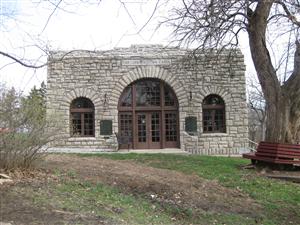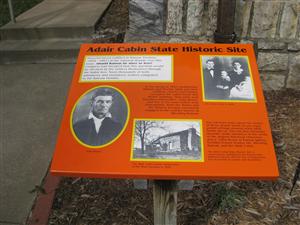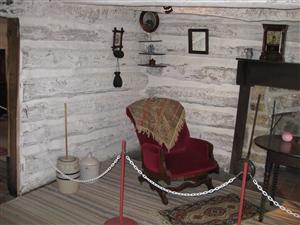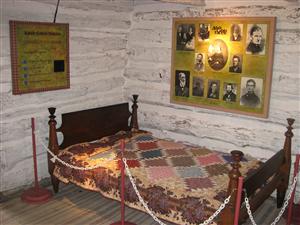John Brown State Historic Site
Tour Stop
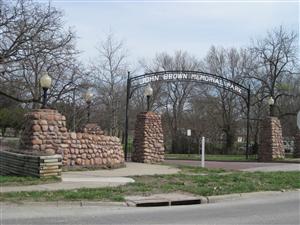
- Return to your car and continue heading west on Main Street.
- The entrance to The John Brown State Historic Site is about one block ahead on the right.
- Find a place to park and walk around to northwest corner of the building.
- You should see an interpretive sign [Waypoint = N38 29.936 W94 57.584 ] for the Battle of Osawatomie.
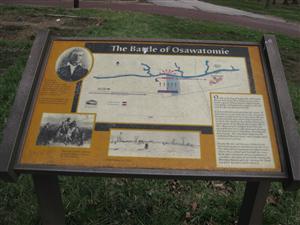
“On the morning of August 30, 1856, John Brown led about 30 anti-slavery men into battle against 250 proslavery Missourians. The Battle of Osawatomie raged on the site of John Brown Memorial Park.”
“Local tradition maintains that the statue of John Brown is located where the mounted proslavery men fired their first shots. Brown positioned his men about four hundred yards to the north in the timber lining the south bank of the Marais des Cygnes River. The Missourians charged down the hill toward Brown's men with their guns blazing. The free-state force held firm, checking the first charge. The attackers dismounted, outflanked Brown's force, and brought their cannon into action.”
“Finally Brown and his men bolted from their hiding places and fled across the river. The Missourians swarmed into Osawatomie, where they sacked and burned the town. Both sides sustained about a half dozen casualties, the most of any battle during the Bleeding Kansas period. Among the dead was John Brown's son, Frederick.”
"'God sees it. I have only a short time to live - only one death to die, and I will die fighting for this cause. There will be no more peace in this land until slavery is done for.'"
-Attributed to John Brown by his son Jason while they watched Osawatomie burn.
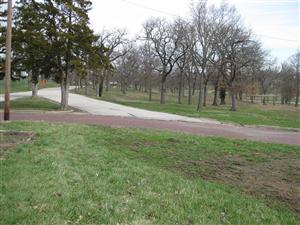
Several weeks later the Reverend Samuel L. Adair wrote a letter in which he described the pro-slavery actions against free-state settlers in Osawatomie:
“A company of Georgians & others came ... & camped near our town – some 4 miles off – They soon commenced running off the horses of free State men into Missouri. In the space of [xxx] days eighteen were missing – 14 from free state men, & 4 from Indians – nine were seen at one time in their possession, all having taken in one night. Cattle were slautered by them – etc-
A company of free collected to rout them – they got word of it – left carrying off what they considered most valuable as far as they could – horses & guns were all taken with them. In their block house, or fort, was found several hundred dollars worth of ready made clothing, jewelry and other articles which had probably all, or nearly all been taken when Lawrence was sacked. Some provision & groceries were left by them. They went to Missouri, & now for four days rumors are constantly reaching us that a large force is coming to sack & burn our place. If they can find the people here of their guard, or if they can get a large enough force, I have no doubt they will try it.”

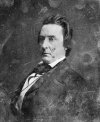 During the summer of 1856, an armed free-state militia began operating out of Lawrence, Kansas and dubbed Lane's Army of the North because it had been raised by James Henry Lane. There were three successive victories over the pro-slavery strongholds of Fort Franklin, Fort Saunders and Fort Titus. Territorial Governor Shannon became extremely frustrated with the unending violence and resigned as governor. In response, David Rice Atchison called for Missourians to “rally instantly to the rescue”. A large pro-slavery militia force headed into Kansas Territory. About 300 – 400 of this militia under the command of John W. Reid split off and headed for Osawatomie, Kansas. They were going after old John Brown.
During the summer of 1856, an armed free-state militia began operating out of Lawrence, Kansas and dubbed Lane's Army of the North because it had been raised by James Henry Lane. There were three successive victories over the pro-slavery strongholds of Fort Franklin, Fort Saunders and Fort Titus. Territorial Governor Shannon became extremely frustrated with the unending violence and resigned as governor. In response, David Rice Atchison called for Missourians to “rally instantly to the rescue”. A large pro-slavery militia force headed into Kansas Territory. About 300 – 400 of this militia under the command of John W. Reid split off and headed for Osawatomie, Kansas. They were going after old John Brown.
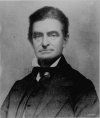 Before sunrise on the morning of August 30th, Frederick Brown, one of John Brown's sons, was on his way over to Samuel L. Adair's cabin. He had letters and was preparing to go to Lawrence. Just before he arrived at the cabin, he was met by an advance party from the pro-slavery militia. Reid's militia had a local guide, the Reverend Martin White, who was leading the advance party. White recognized Frederick Brown and shot him dead. Upon hearing the gun fire, Adair came out of his cabin and soon realized what had happened. He sent his 13-year-old son, Charles, off to warn old John Brown, who was camped nearby.
Before sunrise on the morning of August 30th, Frederick Brown, one of John Brown's sons, was on his way over to Samuel L. Adair's cabin. He had letters and was preparing to go to Lawrence. Just before he arrived at the cabin, he was met by an advance party from the pro-slavery militia. Reid's militia had a local guide, the Reverend Martin White, who was leading the advance party. White recognized Frederick Brown and shot him dead. Upon hearing the gun fire, Adair came out of his cabin and soon realized what had happened. He sent his 13-year-old son, Charles, off to warn old John Brown, who was camped nearby.
Spencer Kellogg Brown was a young teenager living in Osawatomie at the time of the Missourian invasion. He kept a diary of his life during this time:
“Our house was on a high hill commanding the west entrance to the town and was occupied by a number of young men armed for its defense. Only my brother and I were at home, father being in Lawrence after supplies for the defenders of the place. About Sunrise we descried the enemy, first from our house, the morning of August 30th. A shot was heard when some one of our little garrison, cried out that the Missourians were coming, whereupon I immediately ran to the door and gave the alarm. They were in full view and pretty close. … the enemy were forming on the hill and numbered about 200, but I afterwards learned they were nearly 400.”
John Brown reacted quickly and recruited around 40 or so free-state men to defend the town. Brown would show his force and try to get the Missourians to come after him, thus leading them away from Osawatomie. But Reid had a cannon at his disposal and his overwhelming numbers forced Brown to set up his line of defense on the south side of the Marais Des Cygnes River. There they fought the Missourians until, running low on ammunition, were forced to withdraw to the north side of the river. Reid, the pro-slavery commander, chose not to pursue Brown across the river. Instead , they sacked, plundered, and set fire to Osawatomie, before leaving the area.
Spencer K. Brown would be captured by the Missourians. He described the plundering by the Missourians:
“I heard the word given to burn the town which made a very hot fire. After that they loaded the wagons with the goods plundered from the houses. One of them ordered me to put the chairs on the wagon which I did not do, wherewith he came running at me with his bayonet, cursing and threatening to “stick” me if I did not do it.”
“When on their retreat from the town, they stopped at our house while they plundered and then burnt it. They attempted to get out the piano, but in the excitement and heat of the rapidly spreading flames they were compelled to drop it in the doorway, two partly burnt legs and the iron frame only remained to tell the story of its final end.”
One week after the fighting, John Brown wrote about the experience to his wife, Mary:
“On the morning of the 30th Aug an attack was made by the ruffians on Osawatomie numbering some 400 by whose scouts our dear Fredk was shot dead without warning he supposing them to be Free State men or near as we can learn. One other man a Cousin of Mr. Adair was murdered by them about the same time. At this time I was about 3 miles off where I had some 14 or 15 men over night that I had just enlisted to serve under me as regulars. There I collected as well as I could with some 12 or 15 more & in about ¾ of an Hour attacked them from a wood with thick undergroth, with this force we threw them into confusion for about 15 or 20 minutes during which time we killed & wounded from 70 to 80 of the enemy as they say & then we escaped as well as we could with one killed while escaping; two or three wounded; & as many more missing. Four or Five Free State men were butchered during the day as well. Jason fought bravely by my side during the fight & escaped with me he unhurt. I was struck by a partly spent Grape Canister, or Rifle shot which bruised me some but did not injure me seriously. “Hitherto the Lord both helped me” notwithstanding my afflictions. Things now seem rather quiet just now; but what another Hour will bring I cannot say...”
Now return to the front (south) side of the Stone Pavilion and enter the museum [ Waypoint = N38 29.929 W94 57.574 ]. In 1928, the Stone Pavilion was built to protect the cabin built by the Reverend Samuel L. Adair when he came to Osawatomie, Kansas Territory in 1855. The Adair Cabin State Historic Site interpretive sign has the following text:
“Powerful forces collided in Kansas Territory (a854 – 1861) in the national dispute over this issue: should Kansas be slave or free? Congress had declared that this question would be decided by the settlers themselves through the ballot box. Soon thousands of both antislavery and proslavery settlers emigrated to the Kansas frontier.”
“In the spring of 1855, abolitionists Samuel and Fiorella Adair and their children, Charles and Emma, occupied the cabin inside this shelter building. That same year Fiorella's half-brother, John Brown, and five of his sons settled near Osawatomie. Both the Adairs and the Browns became intensively engaged in the conflict known as Bleeding Kansas.”
“You will learn more about the stories of these people inside as you enjoy the period settings showing many Adair family pieces. You will also encounter dramatic audio narratives in the words of the original historic characters and a 'John Brown in Kansas' gallery. Exhibits feature frontier life, Bleeding Kansas, and the Adair Cabin.”
“The Adair Cabin State Historic Site is cooperatively managed by the Kansas State Historical Society and the City of Osawatomie. It is accessible to people with disabilities.”
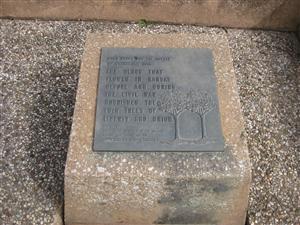
“John Brown and the Battle of Osawatomie 1856
The blood that flowed In Kansas before and during the Civil War nourished the Twin Trees of Liberty and Union.
Erected by United States Department of the Interior, National Park Service and the State of Kansas with the City of Osawatomie 1969”
Further to the east of the building is the John Brown Statue [ Waypoint = N38 29.920 W94 57.532 ]. 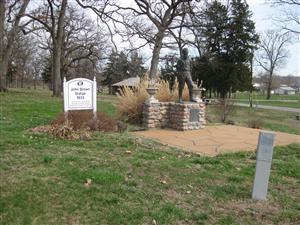
“Captain John Brown 1800-1859”
“Erected May 9, 1935 by The Women's Relief Corps. Department of Kansas Auxiliary to the Grand Army.”
“'John Brown of Kansas He Dared Begin He Lost But Losing Won.' Eugene F. Ware”
Back: The Soldiers Monument
Next: Fort Montgomery

